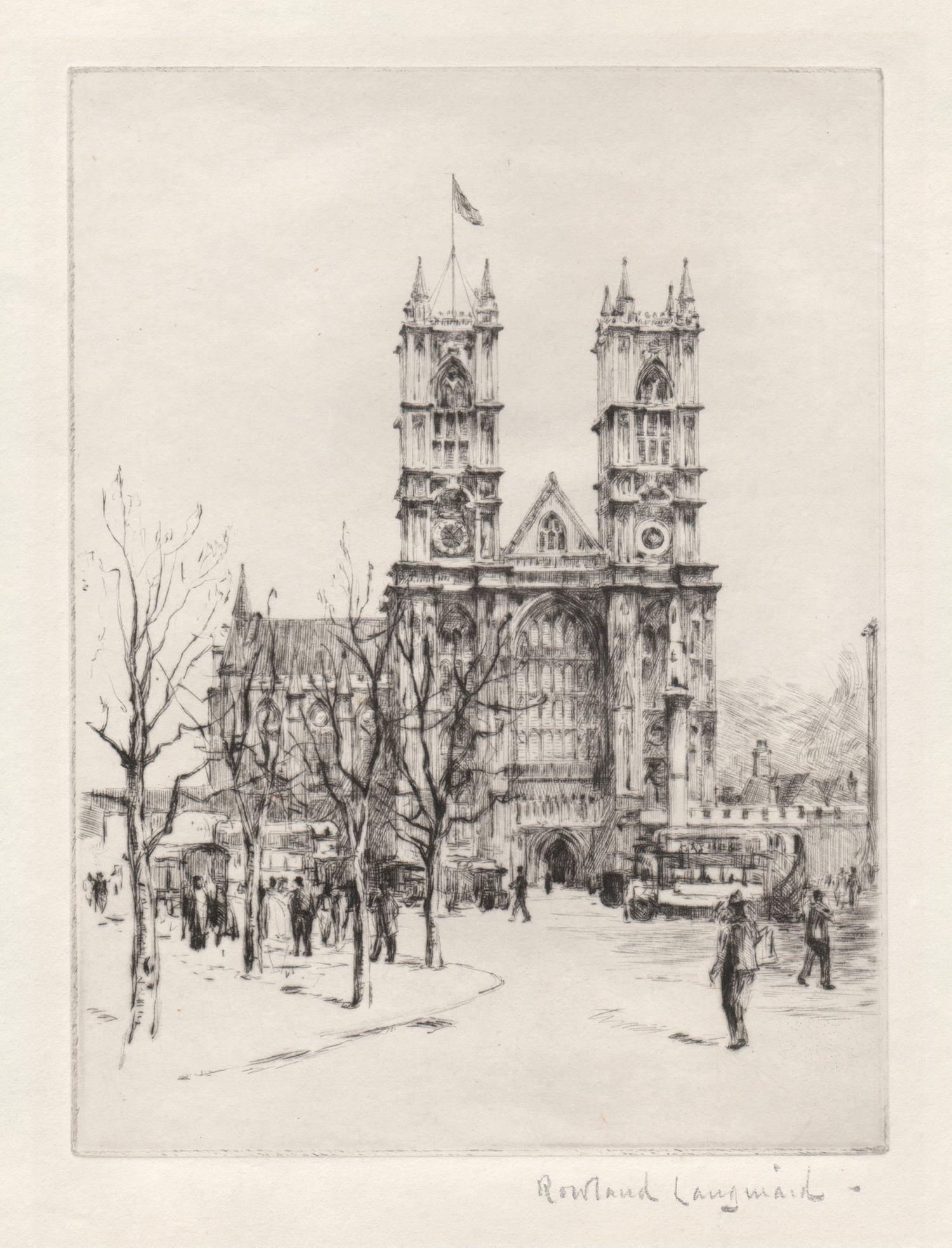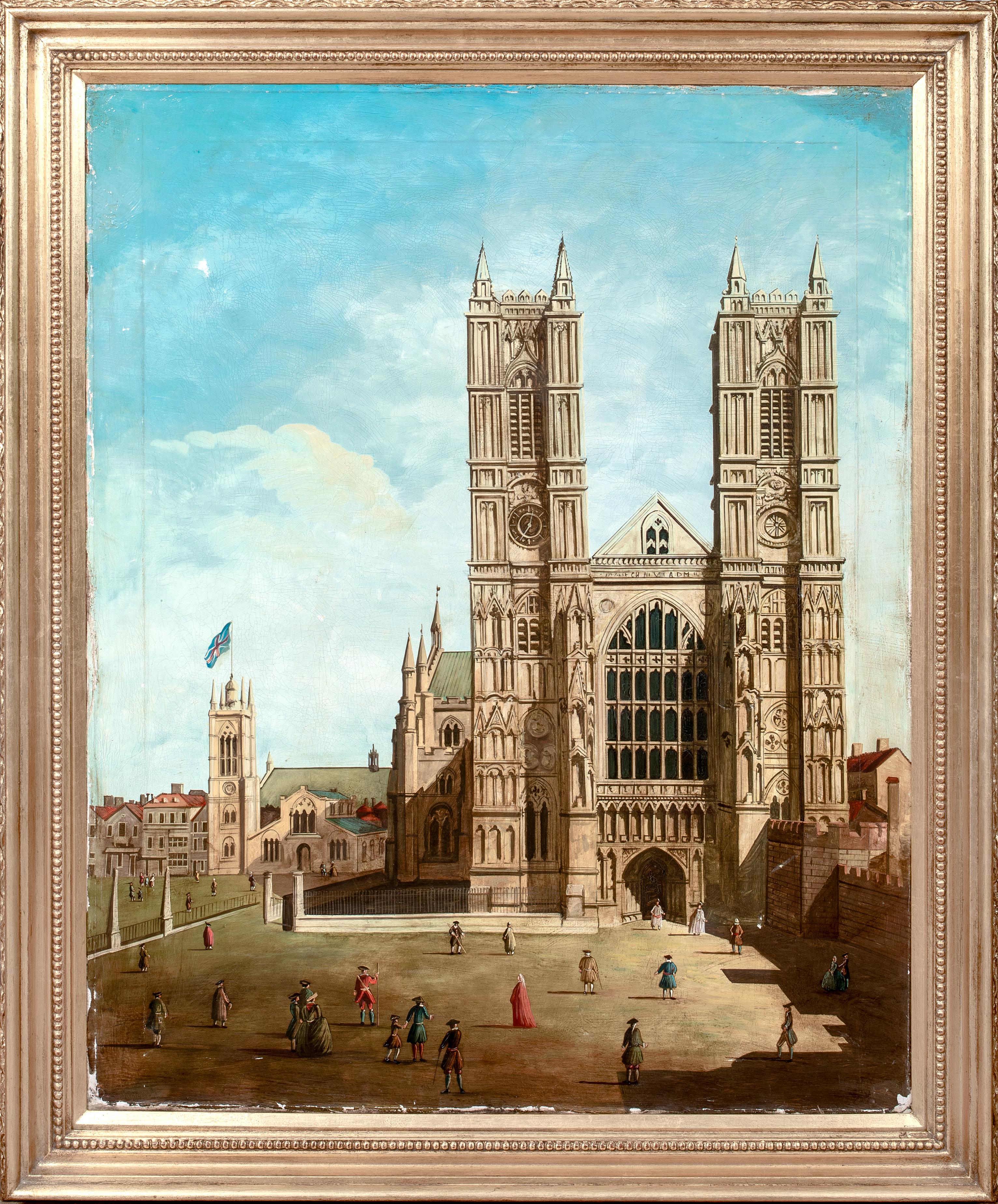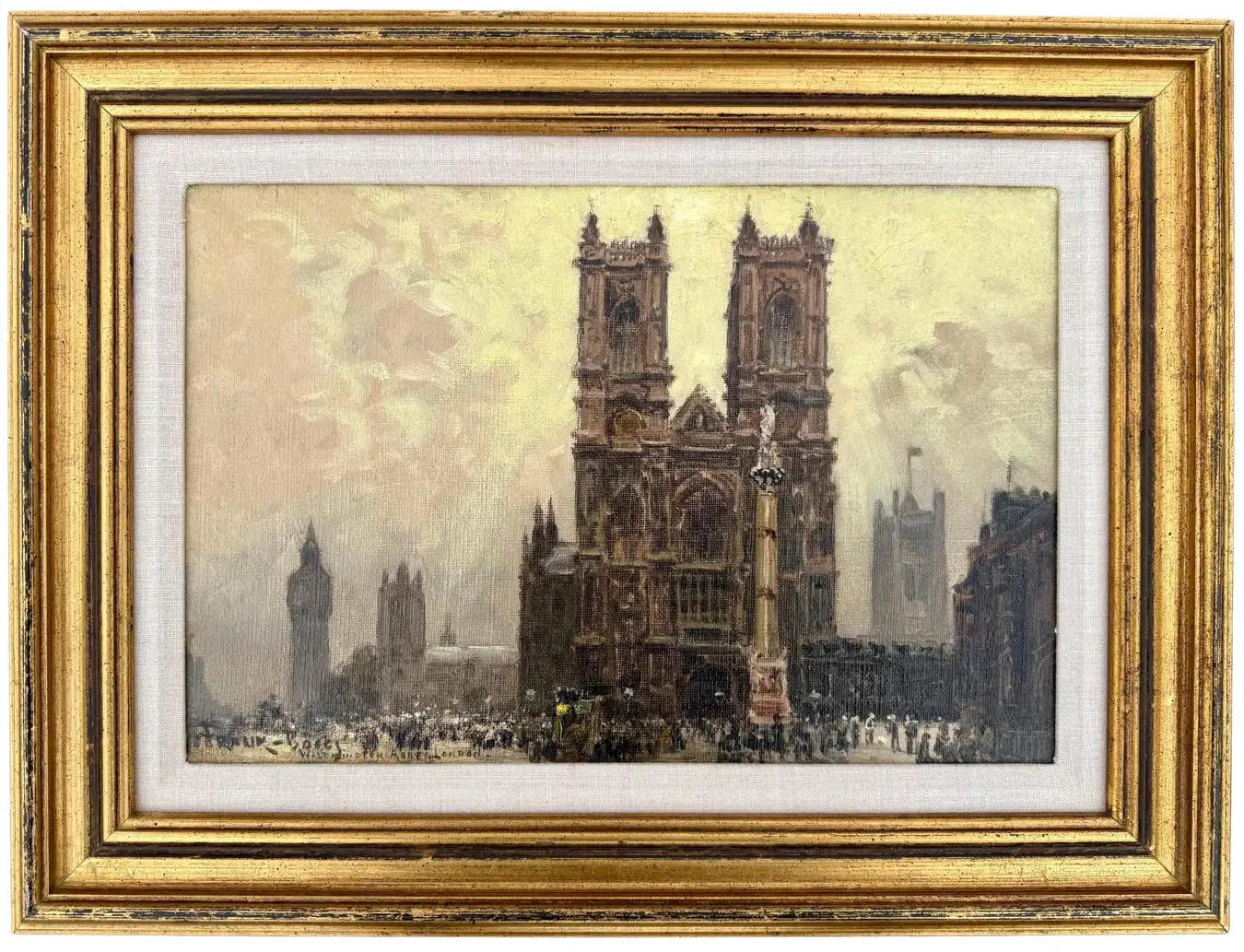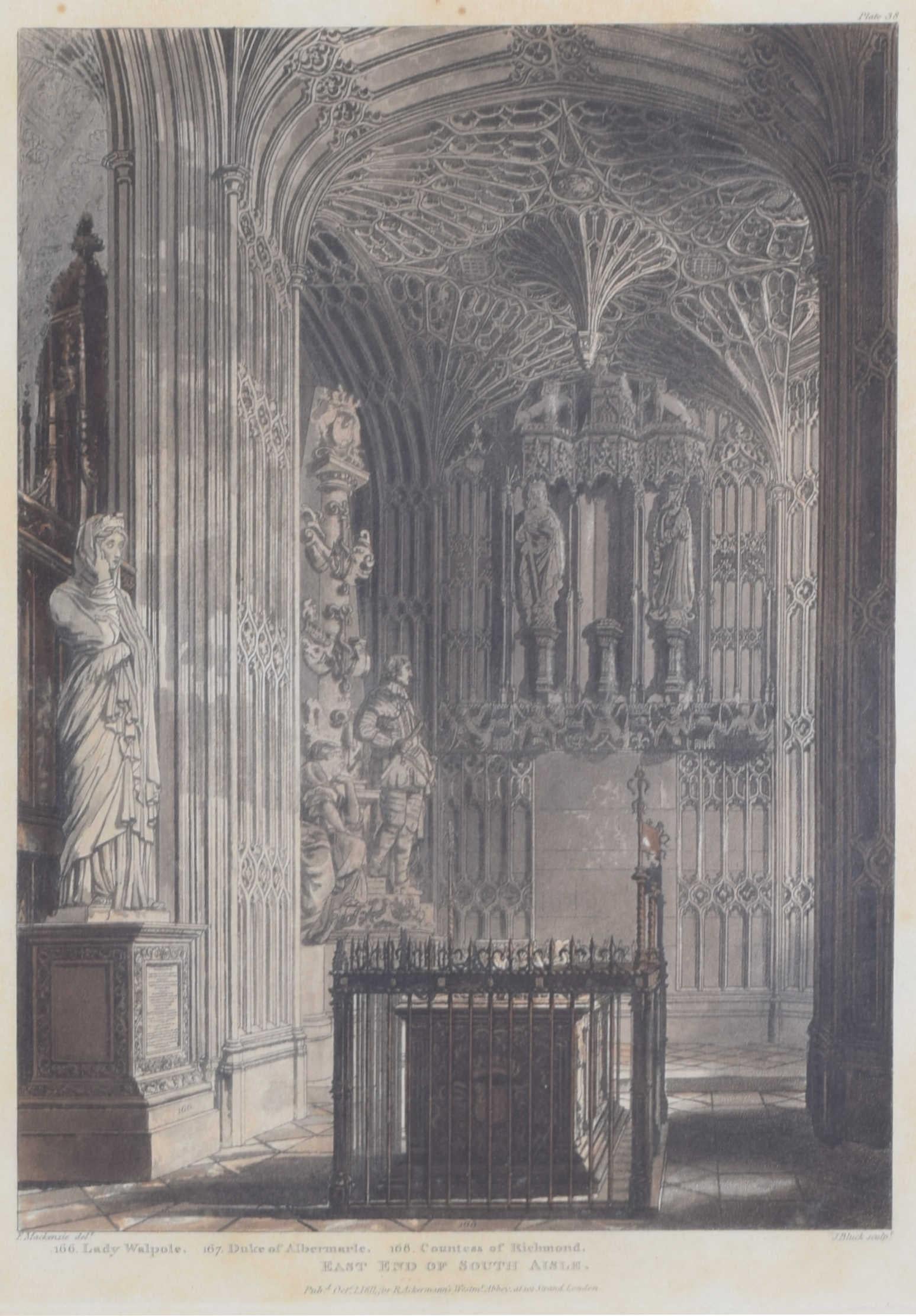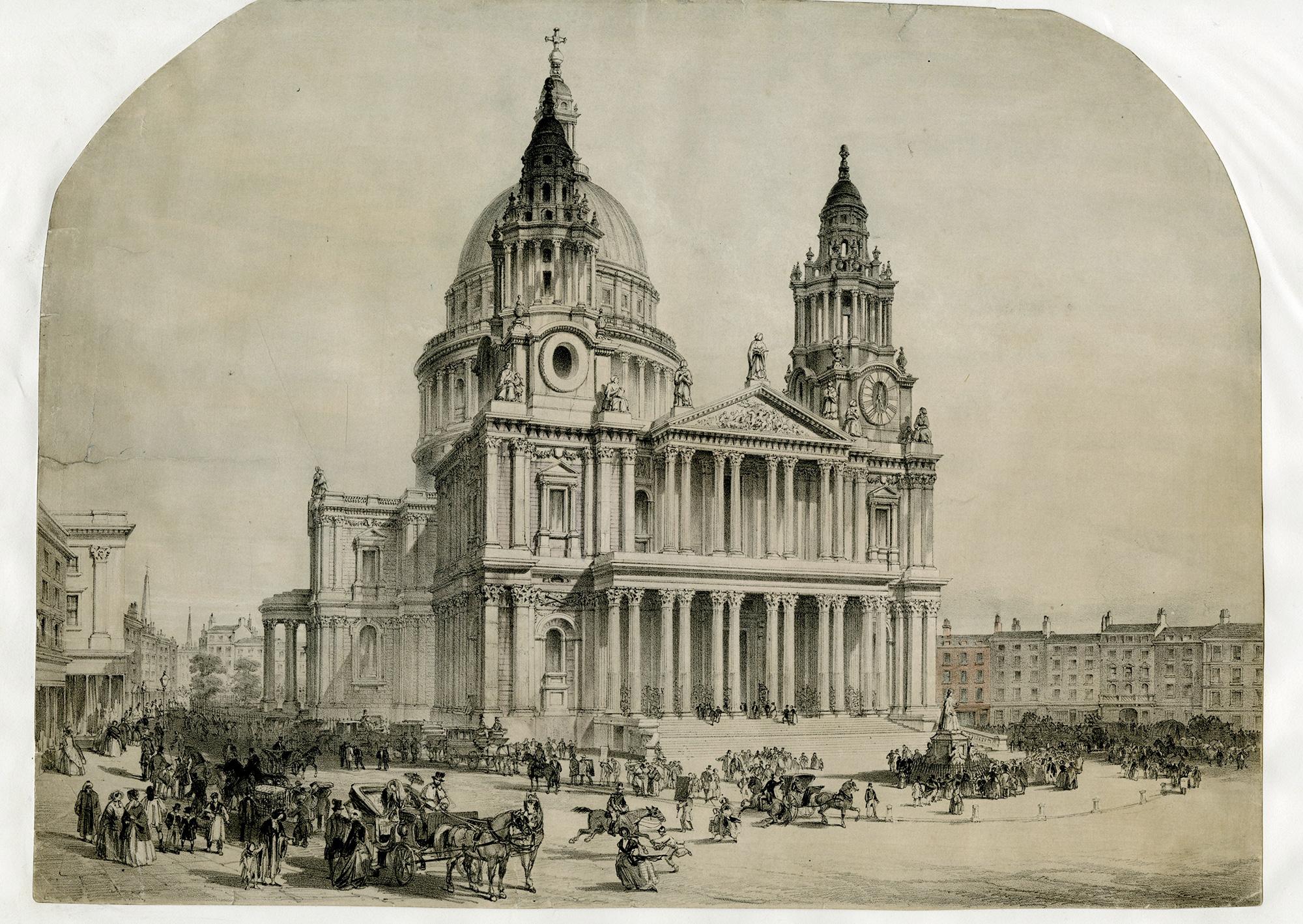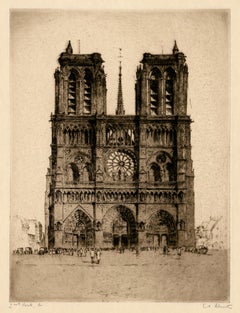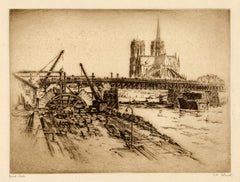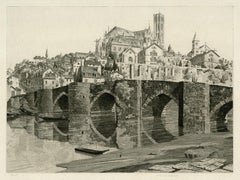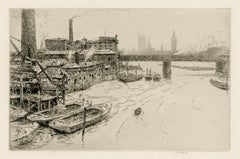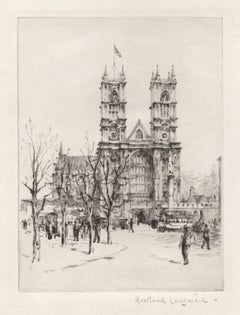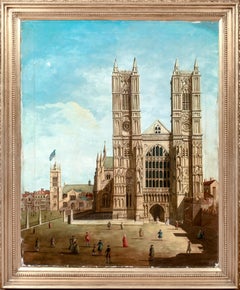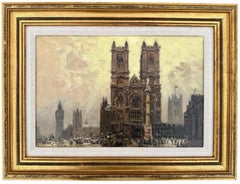Items Similar to 'Westminster Abbey' — Royal Church, London
Want more images or videos?
Request additional images or videos from the seller
1 of 3
Anton Schutz'Westminster Abbey' — Royal Church, London1927
1927
$350
£263.99
€304.91
CA$490.37
A$545.27
CHF 285.46
MX$6,660.55
NOK 3,587.06
SEK 3,374.34
DKK 2,276.14
About the Item
Anton Schutz, 'Westminster Abbey', etching, edition not stated, 1927. Signed in pencil. Signed and dated in the plate, lower left. A superb, richly-inked impression, with skillfully-controlled plate tone, on cream wove paper; the full sheet with margins (3/4 to 2 inches), in excellent condition. Image size 11 7/8 x 8 7/8 inches (302 x 225 mm); sheet size 15 5/8 x 10 3/4 inches (397 x 273 mm). Archivally matted to museum standards, unframed.
Image size 11 7/8 x 8 7/8 inches (302 x 225 mm); sheet size 15 5/8 x 10 3/4 inches (397 x 273 mm).
ABOUT THE IMAGE
Westminster Abbey, formally titled the Collegiate Church of Saint Peter at Westminster, is an Anglican church in the City of Westminster, London, England. Since 1066, it has been the location of the coronations of 40 English and British monarchs and a burial site for 18 English, Scottish, and British monarchs. At least 16 royal weddings have taken place at the abbey since 1100.
Although the church's origins are obscure, an abbey housing Benedictine monks was on the site by the mid-10th century. The church got its first large building in the 1040s, commissioned by King Edward the Confessor, who is buried inside. Construction of the present church began in 1245 on the orders of Henry III. The monastery was dissolved in 1559, and the church was made a royal peculiar – a Church of England church, accountable directly to the sovereign – by Elizabeth I. The abbey, the Palace of Westminster and St Margaret's Church became a UNESCO World Heritage site in 1987 because of their historic and symbolic significance.
13th-century French and English styles chiefly inspire the church's Gothic architecture, although some sections have earlier Romanesque or later Baroque and modern styles. The Henry VII Chapel, at the east end of the church, is a typical example of Perpendicular Gothic architecture; antiquarian John Leland called it orbis miraculum ("the wonder of the world").
The abbey is the burial site of more than 3,300 people, many prominent in British history: monarchs, prime ministers, poets laureate, actors, musicians, scientists, military leaders, and the Unknown Warrior. Due to the fame of the figures buried there, artist William Morris described the abbey as a "National Valhalla".
ABOUT THE ARTIST
Etcher, painter, and architect Anton Schutz was born in Germany in 1894. He studied at the University of Munich, earning a double degree in mechanical engineering and architecture. His interests then turned to art, and he attended the Academy of Fine Arts in Munich. After completing his artistic studies, Schutz came to the United States in 1924, where he met Joseph Pennell. He assisted Pennell in his classes at the Art Students League, New York, and became his professional associate.
Schutz was commissioned by The New York Times to make etchings of New York and other American cities. He completed a series of illustrations for the magazine section, traveling as far west as San Francisco. Schutz then traveled to Japan, Russia, and China in 1928 and 1929, creating etchings published by The New York Times and the New York Herald Tribune. The United States Chamber of Commerce commissioned him to create a series of twelve etchings on American cities, later reproduced in Nation’s Business Magazine. Other of his etchings featuring European and American cities were included in publications of the Encyclopaedia Britannica. Schutz also served as the president of the New York Graphic Society and the Louis Icart Society.
The works of Anton Schutz are represented in numerous museum collections, including the Library of Congress, the New York Public Library, the Brooklyn Museum, the Chicago Art Institute, the Cleveland Museum of Arts, the British Museum, the Bibliotheque Nationale de Paris, and the Uffizi Galleries in Florence.
- Creator:Anton Schutz (1894-1977, American)
- Creation Year:1927
- Dimensions:Height: 11.88 in (30.18 cm)Width: 8.88 in (22.56 cm)
- Medium:
- Movement & Style:
- Period:
- Condition:
- Gallery Location:Myrtle Beach, SC
- Reference Number:Seller: 1039901stDibs: LU53239216322
About the Seller
5.0
Recognized Seller
These prestigious sellers are industry leaders and represent the highest echelon for item quality and design.
Platinum Seller
Premium sellers with a 4.7+ rating and 24-hour response times
Established in 1995
1stDibs seller since 2016
316 sales on 1stDibs
Typical response time: 1 hour
Associations
International Fine Print Dealers Association
- ShippingRetrieving quote...Shipping from: Myrtle Beach, SC
- Return Policy
Authenticity Guarantee
In the unlikely event there’s an issue with an item’s authenticity, contact us within 1 year for a full refund. DetailsMoney-Back Guarantee
If your item is not as described, is damaged in transit, or does not arrive, contact us within 7 days for a full refund. Details24-Hour Cancellation
You have a 24-hour grace period in which to reconsider your purchase, with no questions asked.Vetted Professional Sellers
Our world-class sellers must adhere to strict standards for service and quality, maintaining the integrity of our listings.Price-Match Guarantee
If you find that a seller listed the same item for a lower price elsewhere, we’ll match it.Trusted Global Delivery
Our best-in-class carrier network provides specialized shipping options worldwide, including custom delivery.More From This Seller
View All'Notre-Dame, Paris' — Historic French Gothic Cathedral
By Anton Schutz
Located in Myrtle Beach, SC
Anton Schutz, 'Notre Dame, Paris', etching, 2nd state, 1927. Signed, titled, and annotated '2nd State', in pencil. Signed and dated in the plate, lower left. A superb, richly-inked...
Category
1920s Realist Figurative Prints
Materials
Etching
'L' Abside de Notre Dame' — Vintage 1920s Paris, Realism
By Anton Schutz
Located in Myrtle Beach, SC
Anton Schutz, 'L' Abside de Notre Dame' (The Apse of Notre Dame), etching, 1st state, c. 1927. Signed, titled, and annotated 'First State', in pencil. A supe...
Category
1920s Realist Figurative Prints
Materials
Etching
Limoges (French Church Series #32)
By John Taylor Arms
Located in Myrtle Beach, SC
John Taylor Arms, 'Limoges (French Church Series #32)', etching, 1932, edition 142, third (final) state impressions, Fletcher 244. Signed, dated, and annotated 'Ed 100 III' in pencil. A superb, finely detailed impression, in warm black ink, on antique, pale gray laid paper, with full margins (1 1/16 to 1 1/2 inches); adhesive stains in the bottom left and right sheet corners, well away from the image, otherwise in excellent condition. Matted to museum standards, unframed.
A view of Limoges, France and the Saint-Martial Bridge from the far side of the Vienne river. According to Fletcher, author of the catalogue raisonné on the artist's graphic work, this etching is among the artist’s preferred plates.
Published references: "An Appreciation to John Taylor Arms 1887-1953", in PRINT, Vol. VIII #5 P. viii, Feb.-March 1954.
Impressions of this print are in the permanent collections of the Davis Museum at Wellesley College, National Gallery of Art, Saint John’s University, Smithsonian Institution, and Wake Forest University.
ABOUT THE ARTIST
“John Taylor Arms will live on and on and future generations centuries from now will marvel at his work... . As a friend and as a man, he fully matched his superb work.” —John Winkler, printmaker
Born in Washington, D.C. in 1887, John Taylor Arms attended the Lawrenceville School and began the study of law at Princeton University. In 1907, he transferred to the Massachusetts Institute of Technology and took up the study of architecture. Arms evolved his unique drafting style, with its highly realistic, precise detail and exquisitely rendered effects of light, from his experience and practice as an architectural student. He graduated in 1911 and completed a master’s degree the following year. He then worked as a draftsman with the well-known Carrere and Hastings Company in New York.
In 1913 Arms was given a hobbyist’s etching set, and he began to dabble with copperplate and acid. In 1915, after copying a handful of prints by Jongkind and other Etching Revivalists, Arms created his first original etching. His early experiments were picturesque views of European villages, reflecting the influence of Whistler. He inked and printed several of these plates in color in the manner of Charles Mielatz...
Category
1930s American Realist Landscape Prints
Materials
Etching
Hungerford Bridge, London
By Kerr Eby
Located in Myrtle Beach, SC
Kerr Eby 'Hungerford Bridge, London', etching and sandpaper ground, 1929, edition 90, Giardina 144. Signed, titled, and annotated 'Ed 90' in pencil. Signed again in the bottom right sheet corner. A fine, atmospheric impression, with delicate plate tone, on cream wove paper; the full sheet with margins (1 1/2 to 1 5/8 inches), in excellent condition. Matted to museum standards, unframed.
Hungerford Foot Bridge spans the River Thames in London, between Westminster Bridge and Waterloo Bridge. Eby visited Great Britain and France during 1924 and 1925.
Impressions of this work are in the permanent collection of the following institutions: American Academy and Institute of Arts and Letters, Arizona State University, Boston Public Library, Davison Art Center (Wesleyan University), Herbert F, Johnson Museum of Art, Huntington Museum of Art, Hood Museum of Art (Dartmouth College), Metropolitan Museum of Art, Montgomery Museum of Fine Arts, National Museum of American Art, New York Public Library, Smithsonian Museum of American Art.
ABOUT THE ARTIST
Kerr Eby was born in 1890 in Tokyo, Japan, the son of Methodist missionaries from Canada. The family returned to Vancouver when Eby was only three, and he grew up studying art encouraged by his parents as his mother was from a family of prominent artists. By age twelve, he had lived in Vancouver, Kingston, Toronto and Bracebridge where he found work as a ‘printer’s devil’ on the local Bracebridge newspaper.
After graduating from high school in 1907, Eby moved to New York City to study art, first at the Pratt Institute, and later at the Art Students League. He enrolled in art classes at Pratt Institute while working for a lithographic firm earning $4.00 a week. His pay barely covered his room and drawing supplies. Within a year, starving and feeling defeated, he returned to Canada and was employed by a surveying party in Northern Ontario. Eby gradually regained his dream of becoming an artist, and in his spare time, he began to draw the surrounding wilderness landscapes. By fall he had returned to New York to attend night classes at the Art Students League while working for another lithographic firm. He spent several more summers surveying in Northern Ontario before he was able to make a living as an illustrator. During this period he formed several friendships with influential artists including John Henry Twachtman and Childe Hassam and joined a summer artists' colony founded by them at Cos Cob, Connecticut. He supported himself by working as a magazine illustrator and at the American Lithographic Company. Through diligent study and practice, Eby refined both his drawing and printmaking techniques.
In 1917, when the United States entered World War I, Eby joined the U.S. Army. Failing to obtain a commission as an artist, he was assigned first to ambulance duty and later as a sergeant in the 40th Engineers in France. He spent most of WWI on the front line as a camouflager of the field artillery ‘big guns”. On his time off duty, he would sketch everything he witnessed, from the explosive big guns and men in action to the dead soldiers in the field. He sent the drawings home each week, and upon his return from the war, they became the basis for his first successful group of etchings. He continued creating his war-related prints throughout the 1920s and '30s as his work became widely exhibited Frederick Keppel, the renowned print dealer and a relative of Eby, became the exclusive agent for many of his print editions.
With another global conflict beginning in the mid-1930s, Eby wanted to show the world the true face of war...
Category
1920s Impressionist Landscape Prints
Materials
Etching
'St. Marks on the Bowery' - Famed New York City Landmark
By Leon Dolice
Located in Myrtle Beach, SC
'St. Mark's Church on the Bowery', aquatint with etching, edition not stated but small, 1932. Signed in pencil. Signed in the plate lower left and titled in the plate lower right. A superb, atmospheric impression, on cream wove paper, with full margins (1 1/8 to 2 inches), in excellent condition. Matted to museum standards, unframed.
Image size 9 3/4 x 7 3/8 inches (248 x 187 mm); sheet size 13 1/8 x 10 inches (333 x 254 mm).
Impressions of this work are held in the collections of the Princeton University Art Museum and the Five College Museums.
ABOUT THE ARTIST
Born in Vienna, Leon Dolice left a secure position in the family business to pursue his artistic interests. He began his art education in his teens and early twenties when he traveled through Europe to study the works of the Old Masters. He immigrated to America in 1920 and made his home in Manhattan. As a printmaker, he chose as his subjects the architecture, back streets, dock scenes, and other aspects of New York City life that were being overtaken by the modern world.
In 1950, learning of the coming demolition of the Third Avenue El, Dolice created a series of Third Avenue and other New York City landmarks that were threatened with extinction. His images from that period provide a record of a New York that has passed into history.
During his lifetime, Dolice exhibited throughout Europe and the United States. Retrospectives of his work include a one-man show of his graphic work at Tribeca Gallery, New York; the traveling exhibition ‘Vintage New York’ with the New Rochelle Council on the Arts; and the Hofstra Museum, Hempstead.
Dolice's works are in the permanent collections of the Museum of the City of New York, the National Gallery of Art, the New York Historical Society, Georgetown University, the Philadelphia Print Club, and the New York Public Library, as well as private and corporate collections.
ABOUT ST. MARKS CHURCH
St. Mark's Church in-the-Bowery is a parish of the Episcopal Church located at 131 East 10th Street, at the intersection of Stuyvesant Street and Second Avenue in the East Village neighborhood of Manhattan in New York City. The property has been the site of continuous Christian worship since the mid-17th century, making it New York City's oldest site of continuous religious practice. The structure is the second-oldest church building in Manhattan.
In 1651, Petrus Stuyvesant, Director General of New Netherland, purchased land for a bowery or farm from the Dutch West India Company and, by 1660, built a family chapel at the present-day site of St. Mark's Church. Stuyvesant died in 1672 and was interred in a vault under the chapel.
Stuyvesant's great-grandson, Petrus "Peter" Stuyvesant, sold the chapel property to the Episcopal Church for $1 in 1793, stipulating that a new chapel be erected to serve Bowery Village, the community which had coalesced around the Stuyvesant family chapel. In 1795, the cornerstone of the present-day St. Mark's Church was laid, and the fieldstone Georgian-style church, built by the architect and mason John McComb Jr., was completed and consecrated on May 9, 1799.[4] Alexander Hamilton provided legal aid in incorporating St. Mark's Church as the first Episcopal parish independent of Trinity Church in New York City. By 1807, the church had as many as two hundred worshipers at its summer services, with 70 during the winter.
While the 19th century saw St. Mark's Church grow through its many construction projects, the 20th century was marked by community service and cultural expansion. Today, the rectory houses the Neighborhood Preservation Center, the Greenwich Village Society for Historic Preservation, and the Historic Districts Council, as well as other preservation and community organizations such as the Poetry Project, the Millennium Film Workshop, and the Danspace Project.
St Mark's has supported an active artistic community since the 19th century. In 1919, poet Kahlil Gibran was appointed a member of the St. Mark's Arts Committee, and the next year, the two prominent Indian statues, "Aspiration" and "Inspiration" by sculptor Solon Borglum...
Category
1930s American Modern Landscape Prints
Materials
Etching, Aquatint
New York Skyline, Sketch
By John Taylor Arms
Located in Myrtle Beach, SC
A fine impression, on cream wove paper, with full margins (5/8 to 1 3/8 inches), in excellent condition. Edition 20. Signed and dated in pencil. Annotated 'Bolton Brown...
Category
1920s American Realist Landscape Prints
Materials
Lithograph
You May Also Like
Westminster Abbey, London. Rowland Langmaid signed artist etching print
By Rowland Langmaid
Located in Melbourne, Victoria
Westminster Abbey.
Signed in pencil by the artist below the image.
Rowland Langmaid was a marine painter and etcher who studied under William Lione...
Category
1930s English School Landscape Prints
Materials
Etching
Westminster Abbey, London, 19th Century - CANALETTO (1697-1768)
By Giovanni Antonio Canal (Canaletto)
Located in Blackwater, GB
Westminster Abbey, London, 19th Century
after CANALETTO (1697-1768)
Large 19th Century view of Westminster Abbey oil on canvas. Excellent quality and condition architectural view ...
Category
19th Century Landscape Paintings
Materials
Canvas, Oil
$4,193 Sale Price
20% Off
Westminster Abbey, London
By Frank Myers Boggs
Located in Wiscasett, ME
Oil on canvas, signed and inscribed in the lower left. This is a wonderful scene of Westminster Abbey in London with sunlight beaming down from above. Dimensions listed include the ...
Category
Late 19th Century Impressionist Landscape Paintings
Materials
Oil
Robert Tavener Westminster Abbey London Lithograph Modern British Art
By Robert Tavener
Located in London, GB
To see our other Modern British Art and views of London, scroll down to "More from this Seller" and below it click on "See all from this Seller" - or send us a message if you cannot ...
Category
1970s Modern Prints and Multiples
Materials
Lithograph
Westminster Abbey South Aisle engraving by John Bluck for Ackermann
Located in London, GB
To see our other Oxford and Cambridge pictures, including an extensive collection of works by Ackermann, scroll down to "More from this Seller" and below it click on "See all from this Seller" - or send us a message if you cannot find the view you want.
John Bluck (early 19th century) after Frederick Mackenzie (1788 - 1854)
East End of South Aisle, Westminster Abbey (1812)
Hand-coloured aquatint
31 x 24 cm
Published by Rudolph Ackermann...
Category
1810s Realist Prints and Multiples
Materials
Aquatint
North View of St. Paul's Cathedral, London / English School
Located in Middletown, NY
London: Tallis & Co., 1851.
Lithograph on cream wove paper, 11 3/4 x 15 3/4 inches (297 x 398 mm), with vaulted margins at the top sheet edge. Significant toning, and some edge wear...
Category
Mid-19th Century English School Landscape Prints
Materials
Lithograph, Handmade Paper
More Ways To Browse
Church Antique
Abbey Antique
Chinese Landscape Plate
Royal Coronation
Scottish China
Palace Of Westminster
Signed Louis Icart
Coronation Plates
King Edward Coronation
Religious Paintings On Copper
Robert Marion
Swarovski Crystal Sculpture
1991 Calendars
Acrylic Sculpture Statue
Antique Oil Painting Holy Family
Bruce Lee
Ceramic Heart Balloon
Framed Thangka
